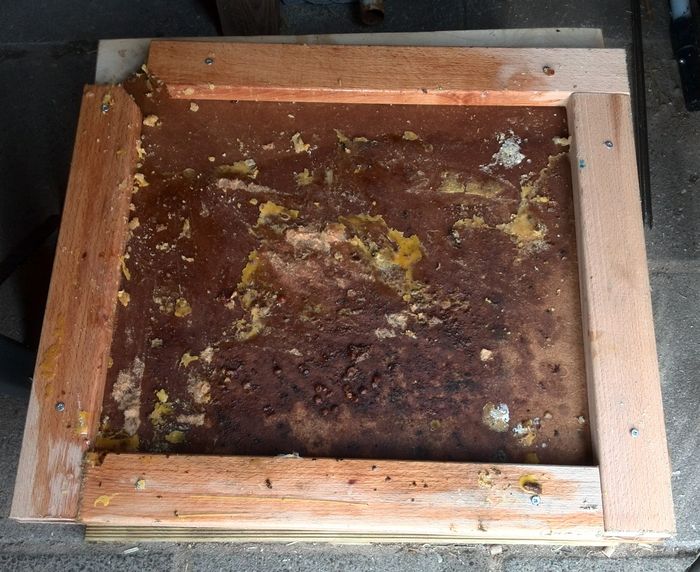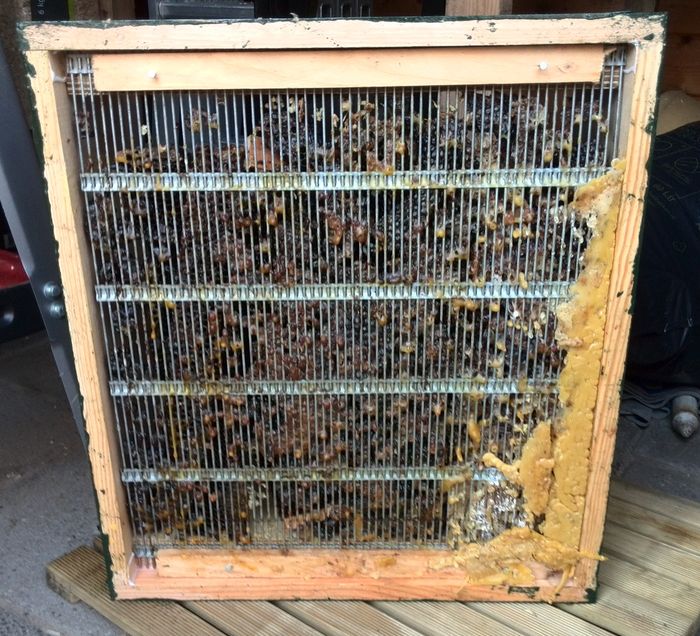ugcheleuce
Field Bee
- Joined
- Apr 15, 2013
- Messages
- 669
- Reaction score
- 1
- Location
- Apeldoorn, Netherlands
- Hive Type
- National
- Number of Hives
- 7-10
Hello everyone
Normally, when I have very little wax to melt, I simply use the kitchen stove, but I've recently obtained about 250 one-year-old frames with drawn-out comb that I would like to clean out of wax efficiently (the foundation used in them was "contaminated" with about 5-10% paraffin wax, so the original beekeeper did not want them, but I can make candles, right?).
Has anyone here ever built a steam wax melter that uses a wallpaper steamer? What are your experiences? What tips can you offer?
I created a test model yesterday by attaching a metal queen excluder to the lug rail of a super, and then turning that super upside down and placing another super on top of it, and using a crown board with a hole in it that's big enough for the steamer pipe, and an eked board at the bottom with one corner sawn off, for the wax to pour out.


https://youtu.be/IWt6feK_FVo
https://youtu.be/SJgVy6H_0Ig
It worked all right, but obviously there were lessons learnt.
1. The crown board buckled quite quickly, so I need to make sure I use stiff wood. It may also be a good idea to use multiple straps to keep everything tight.
2. Steam escaped from between the supers, so it may be best to build a custom box instead of using two supers. Unfortunately I don't have bigger hive bodies available.
3. The bottom board was MDF, and I suspect little bits of it came off during the steaming. I damaged it further when I tried to scrape wax off it.
4. A lot of wax solidified on the bottom board before it ran out of the melter. Perhaps if less steam escapes, it will be hotter at the bottom. Or perhaps I should line the bottom board with e.g. tin foil.
This morning, I expected the wax in the bucket to have solidified into a single mass floating on top of the water, but a lot of wax particles are still separate tiny beads.
It's quite easy to scrape the frames clean after they've been in the steamer, but I find that the frames cool off too quickly after the steamer's lid was removed. I can clean only 4-5 frames before the wax and propolis settles again. And you can't keep the steamer running while the lid is off, because it produces a lot of steam. And it takes a few minutes for the steamer to wake up again after stopping it.
This lead me to thinking that I should make two steam boxes, of e.g. 6-7 frames each, but only one lid, so that the one box can steam while I properly clean the frames in the other box. This will allow me to keep the steamer running constantly but still allow me to access frames to scrape clean. This will also allow me to clean the bottom board while the steamer is busy steaming frames in the bother box.
I'm not sure what material I should use for these boxes. It has to be cheap and should have the capacity to deal with steam. I'm considering making the boxes from tongue-and-groove floor board planks, with very thick corners.
Your thoughts?
Samuel
Normally, when I have very little wax to melt, I simply use the kitchen stove, but I've recently obtained about 250 one-year-old frames with drawn-out comb that I would like to clean out of wax efficiently (the foundation used in them was "contaminated" with about 5-10% paraffin wax, so the original beekeeper did not want them, but I can make candles, right?).
Has anyone here ever built a steam wax melter that uses a wallpaper steamer? What are your experiences? What tips can you offer?
I created a test model yesterday by attaching a metal queen excluder to the lug rail of a super, and then turning that super upside down and placing another super on top of it, and using a crown board with a hole in it that's big enough for the steamer pipe, and an eked board at the bottom with one corner sawn off, for the wax to pour out.


https://youtu.be/IWt6feK_FVo
https://youtu.be/SJgVy6H_0Ig
It worked all right, but obviously there were lessons learnt.
1. The crown board buckled quite quickly, so I need to make sure I use stiff wood. It may also be a good idea to use multiple straps to keep everything tight.
2. Steam escaped from between the supers, so it may be best to build a custom box instead of using two supers. Unfortunately I don't have bigger hive bodies available.
3. The bottom board was MDF, and I suspect little bits of it came off during the steaming. I damaged it further when I tried to scrape wax off it.
4. A lot of wax solidified on the bottom board before it ran out of the melter. Perhaps if less steam escapes, it will be hotter at the bottom. Or perhaps I should line the bottom board with e.g. tin foil.
This morning, I expected the wax in the bucket to have solidified into a single mass floating on top of the water, but a lot of wax particles are still separate tiny beads.
It's quite easy to scrape the frames clean after they've been in the steamer, but I find that the frames cool off too quickly after the steamer's lid was removed. I can clean only 4-5 frames before the wax and propolis settles again. And you can't keep the steamer running while the lid is off, because it produces a lot of steam. And it takes a few minutes for the steamer to wake up again after stopping it.
This lead me to thinking that I should make two steam boxes, of e.g. 6-7 frames each, but only one lid, so that the one box can steam while I properly clean the frames in the other box. This will allow me to keep the steamer running constantly but still allow me to access frames to scrape clean. This will also allow me to clean the bottom board while the steamer is busy steaming frames in the bother box.
I'm not sure what material I should use for these boxes. It has to be cheap and should have the capacity to deal with steam. I'm considering making the boxes from tongue-and-groove floor board planks, with very thick corners.
Your thoughts?
Samuel





